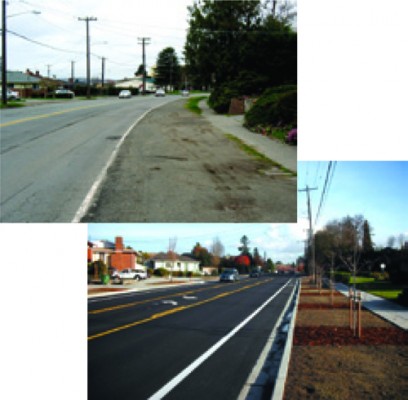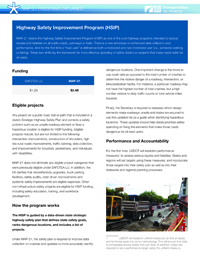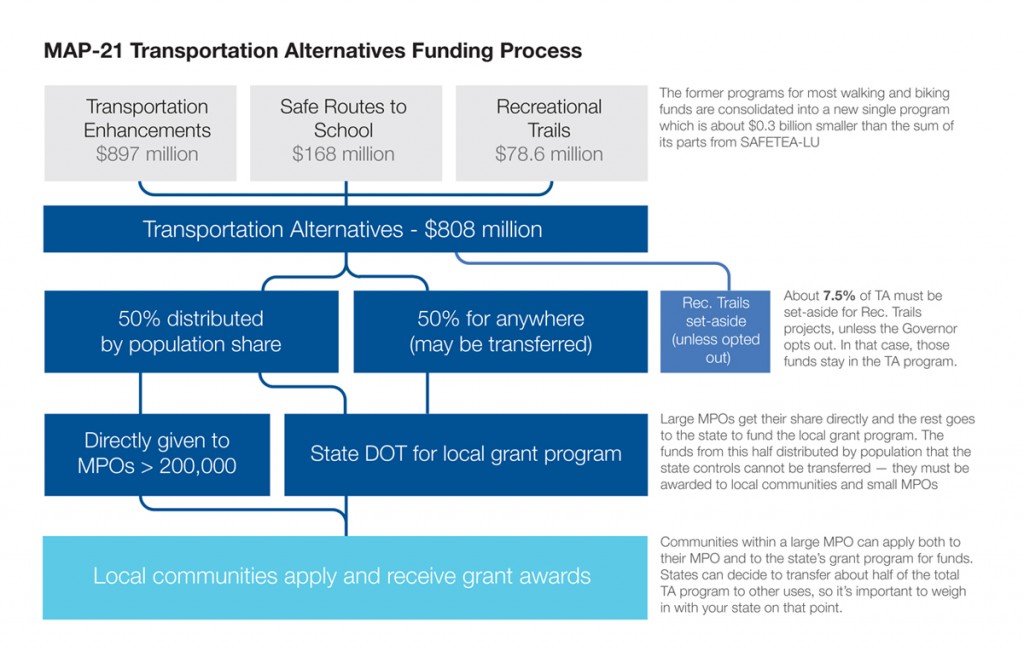Transportation Alternatives (New)
For years, federal transportation law has provided dedicated funding to make biking and walking safer and more convenient through three main programs: (1) Transportation Enhancements (TE), (2) Safe Routes to School (SRTS) and (3) Recreational Trails (Rec Trails) — with the majority of annual funding coming through the Transportation Enhancements program. Under the old law (SAFETEA-LU) states were required to spend about 1.5 percent of their total transportation funds on Transportation Enhancements. With bike and pedestrian projects comprising some of the eligible uses, this was the single biggest source of funds for safe walking and biking.
MAP-21 consolidates these three programs into the new Transportation Alternatives (TA) program. Instead of a state requirement to spend a percentage of funds, local applicants will compete for grants to fund a broad range of activities that provide transportation options, improve safety and enhance economic vitality.
The inclusion of the Cardin-Cochran provision was instrumental in retaining some amount of dedicated funding through the creation of the grant program for local communities to make their streets safer for walking or biking.
Funding
SAFETEA-LU (Transportation Enhancements, Safe Routes to Schools, and Rec. Trails): $1.12 billion
MAP-21 Transportation Alternatives: $0.808 billion
Funding for this new consolidated TA program is unfortunately much lower than the dedicated funding levels under SAFETEA-LU. In addition, MAP-21 provides states with the authority to transfer up to half of the TA money out of the program to fund other unrelated projects. This combination of reduced funding and increased flexibility could have a substantial negative impact on local community efforts to make their streets safer and improve quality of life.
Eligible projects
 Most projects eligible under the former programs remain eligible for TA funding: (Projects newly eligible are bolded.)
Most projects eligible under the former programs remain eligible for TA funding: (Projects newly eligible are bolded.)
Bicycle and pedestrian facilities, safe routes projects for non-drivers, construction of turnouts and overlooks, community improvement activities including vegetation management, historic preservation, rails to trails, control of outdoor advertising, archeological activities related to transportation project, boulevard construction, any environmental mitigation activity including NEPA compliance.
This last addition could be damaging, as environmental mitigation projects can be extremely expensive and consume the entire TA program for a state, leaving little or no money for bike and pedestrian, safe routes, and other trail projects. Old TE uses of “scenic easements” and “transportation museums” are no longer eligible under the TA program.
How the program works
In short, states will administer the funds through a grant program for most of the state, with large metro areas in control of awarding their relative share (see graphic below.)
TA funding will be awarded through a competitive grant process established and run by states along with Metropolitan Planning Organizations (MPOs) that represent over 200,000 in population. Local and regional entities, including governments, transit agencies, transportation authorities, schools and natural resource agencies, may apply for these grants. State departments of transportation may not apply, but if there is no local demand for these projects and a state doesn’t receive any applications, that state may either use that funding for TA projects or opt out of the program for that year.
A portion of funding equal to the former Recreational Trails program ($84 million total in 2009 — or about 7.5% of the total TA program) will be set aside for recreational trail projects, which would further reduce the available funding for states and MPOs to disburse as grants, unless a state opts out of this provision entirely and keeps that slice of funding in the TA program
Program Funding Mechanics
Within each state, the total TA funding is split in half. One half is guaranteed to be awarded to local communities based on population; for the second half, the state has wide discretion and the freedom to ignore grant requests and transfer money away from TA uses entirely.
That first 50 percent of TA funding will be distributed across a state to local communities according to population share with metro areas over 200,000 people receiving their share directly to fund their own regional grant competition. States will run the grant program for all the areas under 200,000 in population. None of these funds may be transferred.
For the other 50 percent, states will award this money through their competitive grant program. Eligible entities in any area of the state may apply. (See above under “How this program works” to see who can apply.)
States may transfer all of this half of the funding to projects outside the scope of TA, such as road widening or reconstruction.






